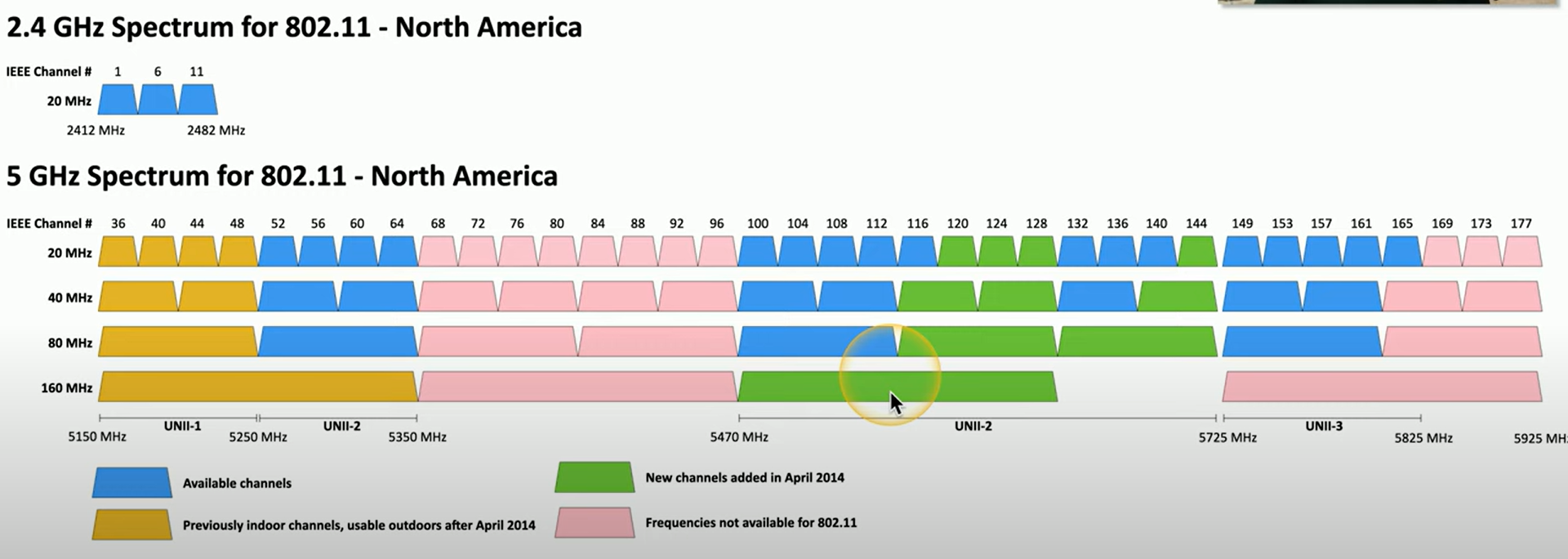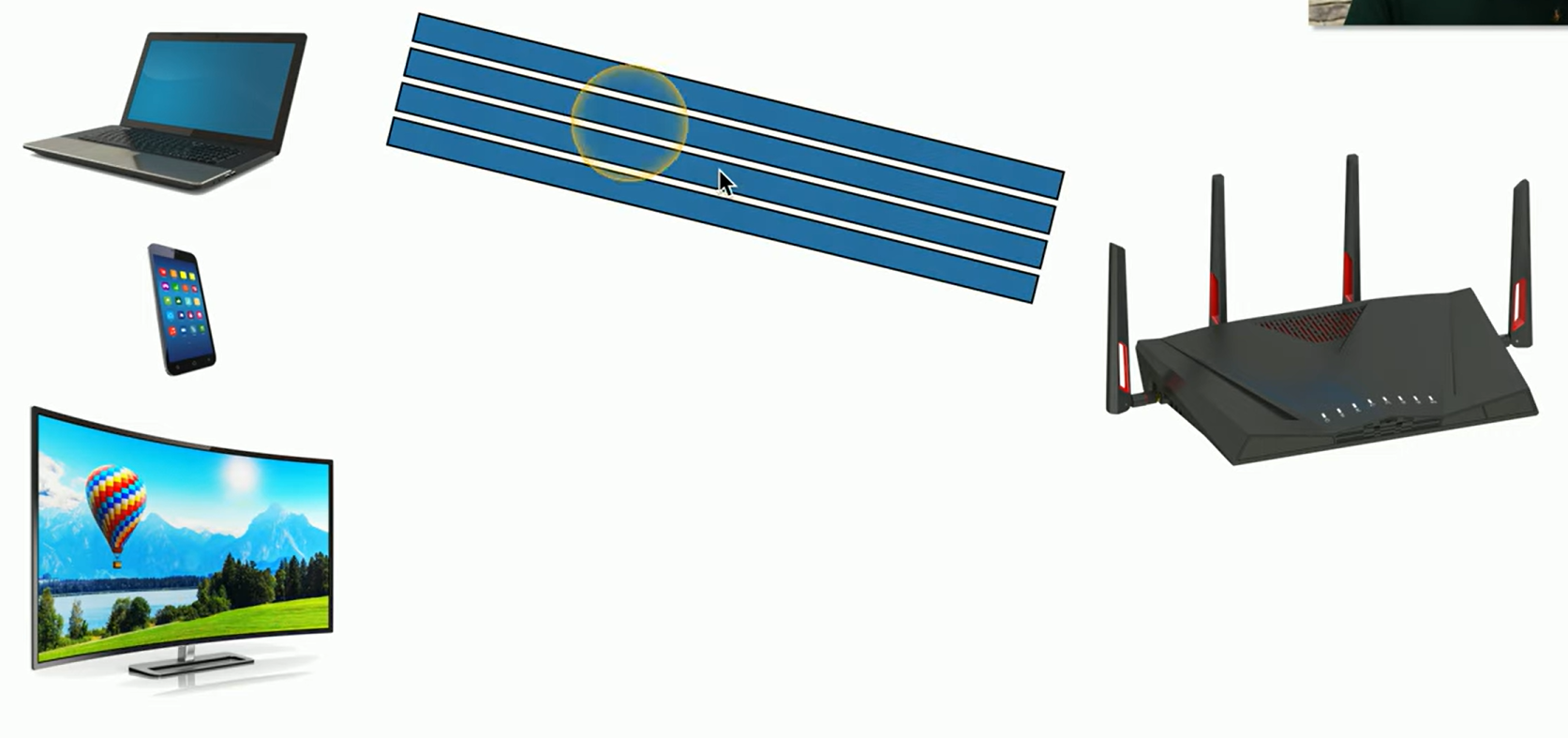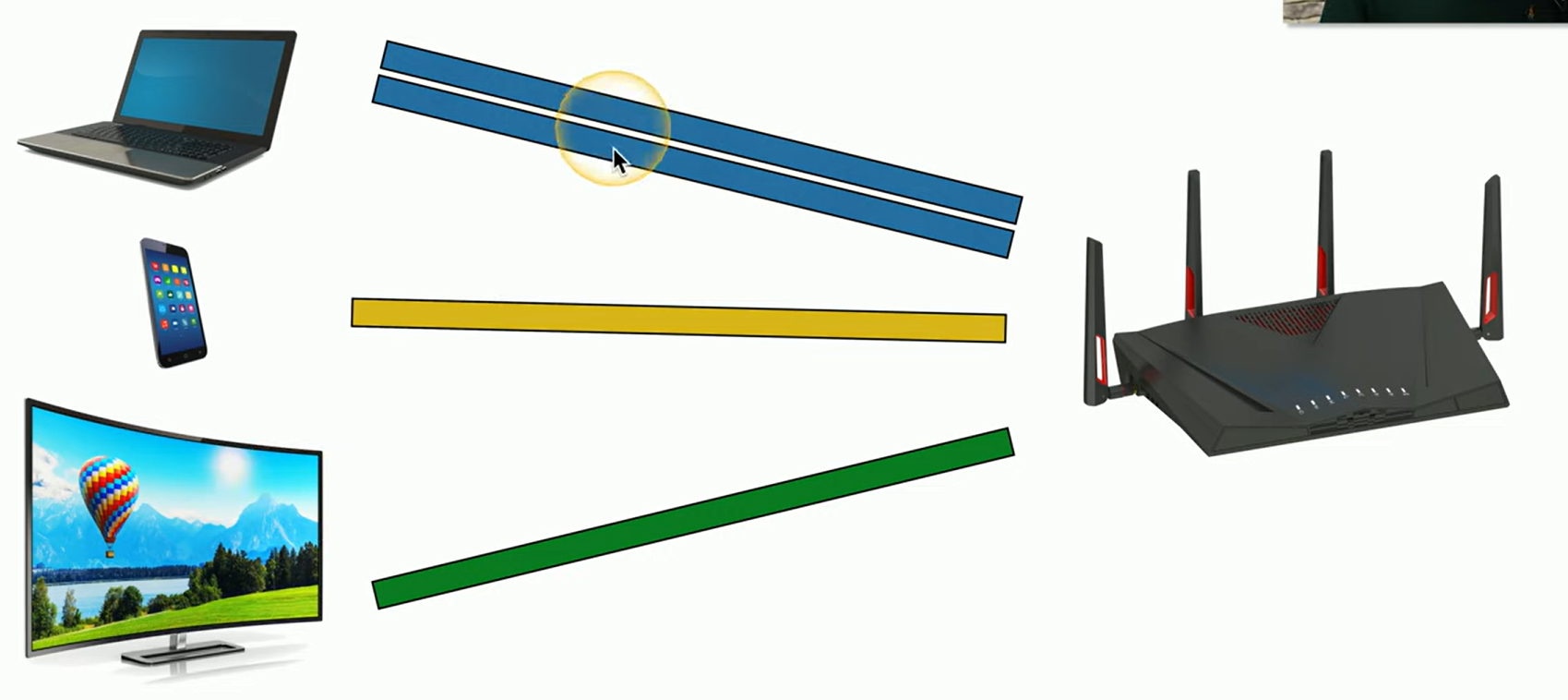Professor Messor 2.4 | Wireless Technologies
1/16
There's no tags or description
Looks like no tags are added yet.
Name | Mastery | Learn | Test | Matching | Spaced |
|---|
No study sessions yet.
17 Terms
802.11 technologies
Operate on either 2.4 GHz or 5 GHz frequencies, sometimes using both and occasionally additional bands. Channels are groups of frequencies numbered by the IEEE; for example, channel 6 on a 2.4 GHz network is the same across all 802.11 devices. Optimal performance is achieved by using non-overlapping channels. Bandwidth refers to the amount of frequency in use, with options like 20 MHz, 40 MHz, 80 MHz, and 160 MHz.

Band selection and bandwidth
In the 2.4 GHz spectrum used by 802.11 networks, North America offers three non-overlapping channels: channel 1, channel 6, and channel 11, each grouped in 20 MHz blocks. These channels span the 2.4 GHz range from 2,412 MHz to 2,482 MHz. With the introduction of the 5 GHz range, a broader selection of frequencies became available, allowing for larger bandwidths. While 20 MHz channels remain standard, some wireless standards now support 40 MHz, 80 MHz, and even 160 MHz bandwidths.
802.11 channel bandwidths and bonding
802.11a (20 MHz), 802.11b (22 MHz), and 802.11g (20 MHz) utilize smaller bandwidths. The introduction of 802.11n brought increased bandwidth options with 20 MHz, 40 MHz, and 80 MHz channels, where a 40 MHz channel in the 2.4 GHz band uses over 80% of the available bandwidth. However, larger channel widths like 80 MHz are only available in the 5 GHz range.
802.11ac further expanded bandwidth options with 20 MHz, 40 MHz, 80 MHz, 80+80 MHz, and 160 MHz channels. When using 802.11ac in compatibility mode with 802.11n devices, only 40 MHz bandwidth is needed, but native 802.11ac devices require at least 80 MHz. The 160 MHz option can be either contiguous or noncontiguous, bonding two 80 MHz channels.
802.11ax offers similar bandwidth options to 802.11ac, including 20 MHz, 40 MHz, 80 MHz, 80+80 MHz, and 160 MHz.
Independent Basic Service Set (IBSS)
Allows two stations to communicate directly without an access point. This ad hoc connection is created for a specific purpose without prior planning and can be used for temporary or long-term communication. To set up an ad hoc connection, you configure the device with the appropriate access point settings and credentials.
SSID (Service Set Identifier) & BSSID (Basic Service Set Identifier)
Every wireless network requires a name, known as the SSID (Service Set Identifier). In larger organizations, you might notice that the wireless networks across various buildings all share the same SSID, despite being supported by multiple access points. Each access point has a unique hardware address called the BSSID (Basic Service Set Identifier), which is the MAC (Media Access Control) address of the access point.
Extending the network
In larger organizations with multiple access points, the same wireless network name can be used across all of them, simplifying roaming across different parts of the network. This shared network name is called an ESSID (Extended Service Set Identifier). As you move between access points, your device automatically roams without requiring you to manually reconnect.

Extended Service Set Identifier (ESSID) example
Devices in different areas of the building connect to the nearest access point. If you move from one end of the building to the other, your device may lose connection to the original access point but will automatically reconnect to a closer one with the same SSID. This seamless transition occurs because both access points have the same configuration.
New technologies
Introduced with 802.11n, 802.11ac, and 802.11ax to enhance data transmission by sending multiple streams over the same frequency simultaneously.
802.11n introduced MIMO (Multiple Input and Multiple Output), allowing for multiple data streams.
802.11ac expanded this with Downstream MU-MIMO (Multi-user MIMO), enabling multiple clients to receive data simultaneously
802.11ax further advanced this by supporting both Downstream and Upstream MU-MIMO, allowing data to be efficiently transferred in both directions—clients can send data to the server (upstream) and receive data from the server (downstream) simultaneously.
Number of antennas
The number of antennas in 802.11n, 802.11ac, and 802.11ax determines the number of available data streams.
The configuration is represented as (Antennas on the access point) x (Antennas on the client): Number of streams.
For example, a 2x2:2 configuration means there are two antennas on both the access point and the client, supporting two data streams.
Before 802.11n
We would have one access point and a single device at the end. And we were able to send information from one device to the other without any type of multi-user capability.

Multiple Input Multiple Output (MIMO)
Allows devices to send and receive data using multiple antennas, significantly increasing traffic capacity between devices. The data transmitted from the access point bounces off nearby objects but ultimately reaches the receiving device's antennas, where it is reconstructed using advanced digital signal processing. Enables multiple streams of traffic to be sent simultaneously, allowing an access point to efficiently deliver large amounts of data to various devices, such as laptops, mobile phones, and streaming devices, all at once.

MU-MIMO (Multi-User MIMO)
Enhances the capability of MIMO by allowing an access point to split streams and send data to multiple devices simultaneously. For instance, an access point it might allocate two streams to a laptop, one stream to a mobile phone, and another stream to a streaming device, such as a TV.
With 802.11ac, even if a mobile phone does not require all the bandwidth of a full stream, the access point still dedicates an entire stream to it.

MU-MIMO (Multi-User MIMO) and OFDMA (Orthogonal Frequency Division Multiple Access)
Data streams are divided into smaller pieces, allowing the access point to send only the necessary data to each device. For example, if a laptop needs more bandwidth, OFDMA can allocate fractional data within the streams specifically for it, while simultaneously providing data to a mobile phone and a television. This approach ensures that each device receives the appropriate amount of data.
This also means that we can have many more users communicating at the same time on the same 802.11n wireless network, supporting larger densities of users from a single access point.
Omnidirectional antennas
Are among the most common and are typically found on most access points. They distribute the signal evenly in all directions, making them suitable for environments where coverage is needed all around. The term "omni" means "all". For more directed or targeted 802.11 signals, a different type of antenna would be more appropriate.
Directional antennas
Focus the signal in a specific direction, making them ideal for extending a wireless network over longer distances. They are used to send and receive data in a single direction, providing concentrated transmission and reception. Antenna performance is measured in decibels (dB), where an increase of 3 dB represents doubling the signal strength.
Yagi antenna
Able to send information very directionally and usually give you a very high gain.
Parabolic antenna
Focus the signal to a single point